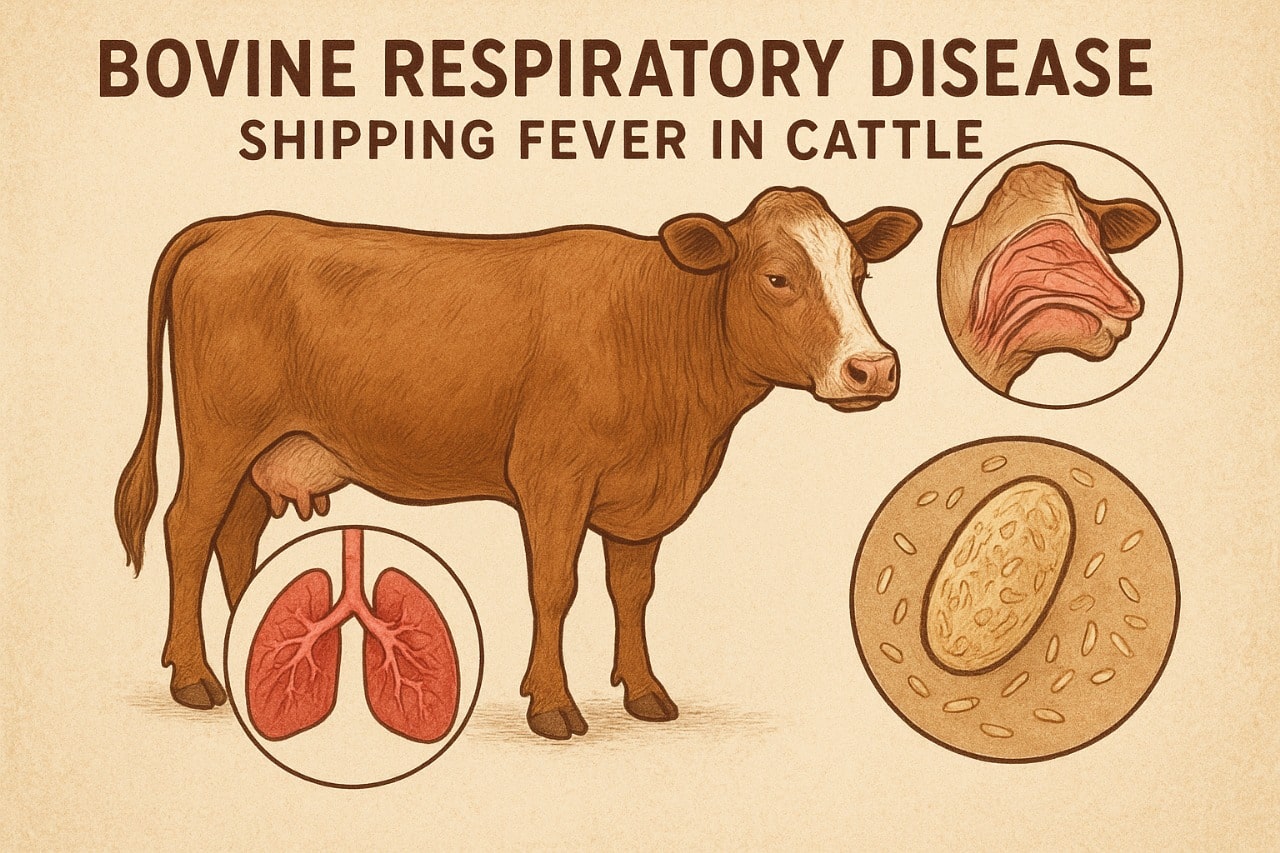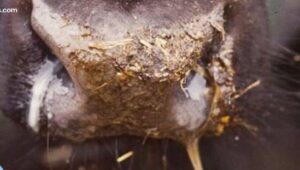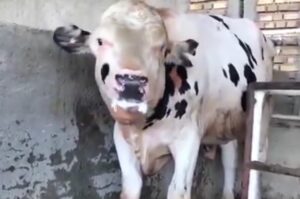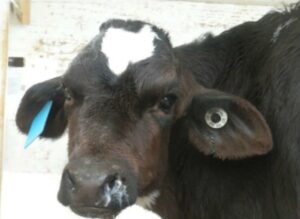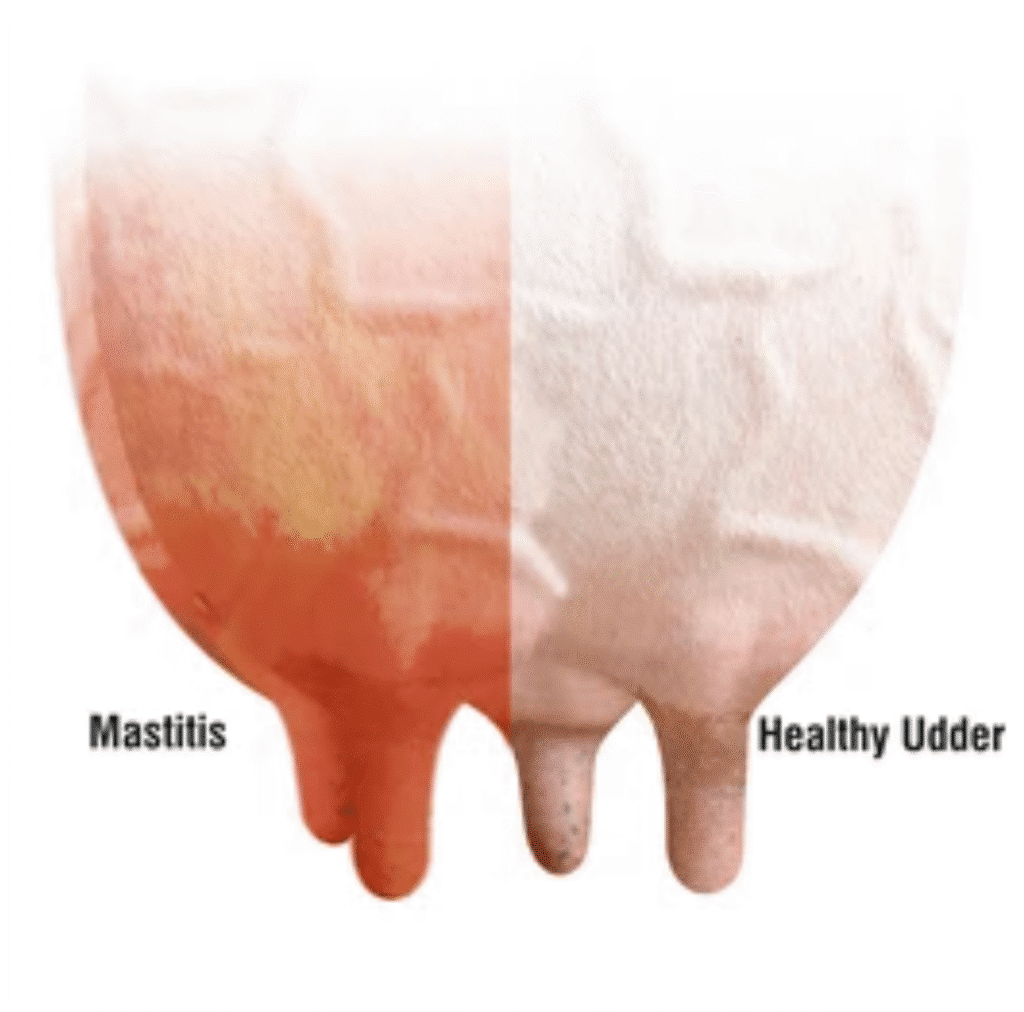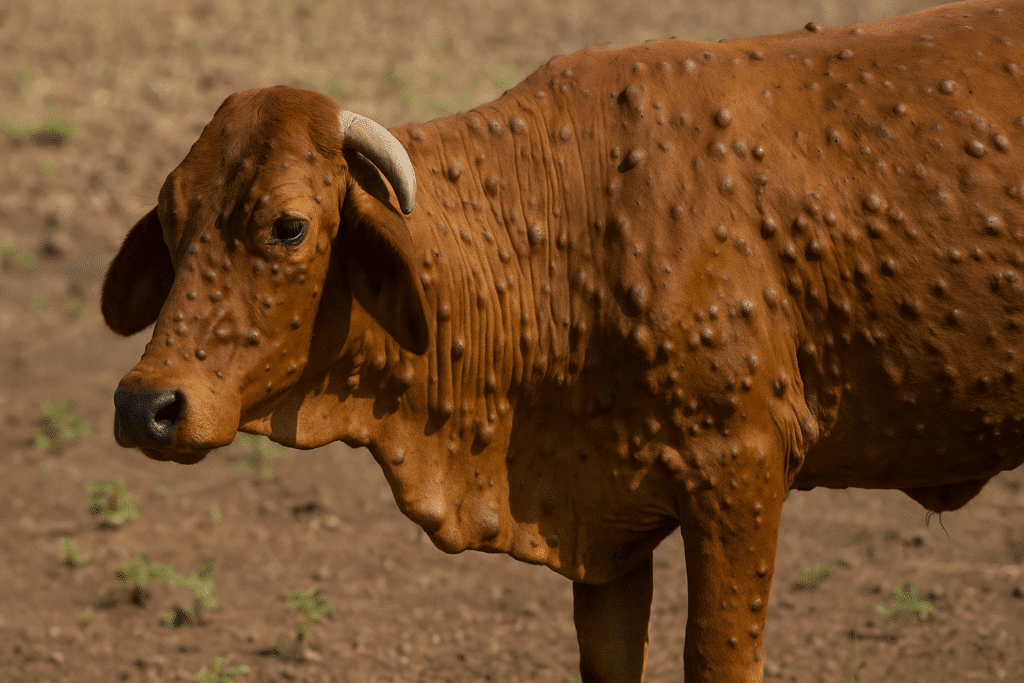Shipping fever in cattle, also known as bovine respiratory disease (BRD) or pneumonic pasteurellosis, is a serious lung infection caused by bacteria, viruses, or stress that often affects cattle after being moved or stressed. It mainly causes bronchopneumonia in cattle. This condition is one of the biggest health problems in cattle herds and can spread quickly if not managed on time.
The disease gets its name because it commonly appears after animals are shipped or transported. Long travel, new surroundings, or sudden weather changes can weaken a cow’s immune system. Once that happens, viruses and bacteria find it easier to attack the lungs. This is why BRD in cattle is often seen in animals that were recently bought, mixed with new herds, or handled under stress.
The main bacteria behind shipping fever are Mannheimia haemolytica, though others like Pasteurella multocida and Histophilus somni can also play a role. These germs usually take advantage after a viral infection, such as IBR, BVD, PI3, or BRSV, damages the respiratory tract. As a result, the lungs become inflamed, fill with fluid, and the animal starts coughing, losing appetite, and breathing heavily.
Early care is crucial. A veterinarian may prescribe antibiotics to stop bacterial growth and supportive medicines to ease fever and swelling in the lungs. To keep the herd healthy, farmers should focus on reducing stress, maintaining pens well-ventilated, feeding properly, and using vaccines that protect against respiratory infections like Mannheimia haemolytica.
Symptoms and Clinical Signs of Shipping Fever in Cattle
The first signs of shipping fever usually show up a few days after animals are moved or go through stress conditions. The affected cattle often run a high fever, between 104°F and 107°F, and start acting dull or tired. They lose interest in feed, move slowly, and sometimes stand away from the herd.
You might also notice a watery discharge from the nose and a mild, dry cough. These early symptoms of bovine respiratory disease are the best time to step in before things get worse.
As the condition develops, the cough becomes harsher and more frequent, and breathing turns fast and heavy. Some animals may even breathe through their mouths, which means the lungs are already struggling. The nasal discharge thickens and turns yellow or cloudy, showing that the infection is deep in the lungs. When you listen closely, you may hear crackling or harsh lung sounds, a clear warning of pneumonia in cattle.
When the disease progresses, the cattle start to look weak. Their ears droop, eyes sink in, and their coat loses shine. In dairy cows, milk production drops, while young animals lose weight or stop growing properly. These are common cow disease symptoms, but in this case, they point to worsening bovine pneumonia symptoms caused by shipping fever.
In severe cases, you’ll see the animal breathing with its mouth open, coughing constantly, and producing thick nasal discharge. The cow may spend more time lying down, refuse to eat, and breathe heavily even while resting. At this stage, pneumonia in cows symptoms are serious and life-threatening, and the animal needs immediate treatment to survive.
Causes of Shipping Fever in Cattle
Shipping fever is mainly caused by a combination of bacteria, viruses, and stress that weakens a cow’s immune system. The leading bacterial culprit is Mannheimia haemolytica, a germ that normally lives in the upper airways of healthy cattle without causing problems. But when an animal becomes stressed or its immunity drops, this bacterium can move down into the lungs and trigger serious bronchopneumonia in cattle.
Other bacteria like Pasteurella multocida, Histophilus somni, and Mycoplasma bovis can also play a part, making the infection even worse. In cases of Mannheimia haemolytica in cattle, the bacteria release powerful toxins that damage lung tissue and cause severe breathing difficulty.
Viruses also play a big role in the development of shipping fever. Some of the most common viruses in cattle that lead to this problem include Bovine Respiratory Syncytial Virus (BRSV), Infectious Bovine Rhinotracheitis Virus (IBR), Parainfluenza-3 Virus (PI3), and Bovine Viral Diarrhea Virus (BVDV). These viruses damage airway linings, allowing bacteria like Mannheimia haemolytica to reach deeper into the lungs.
When this occurs, the lungs get inflamed and filled with fluid, causing fever, coughing, nasal discharge, and reduced appetite in the animal.
The biggest trigger for shipping fever is stress. Long truck rides, overcrowding, sudden weather changes, poor ventilation, and even changes in feed can all stress cattle. Stress triggers hormones such as cortisol, which weaken the immune system and reduce the animal’s ability to fight infections.
That’s why many outbreaks of shipping fever happen a few days after transport or any major handling event. When stress, viruses, and bacteria act together, they lead to the serious lung infections seen in the bovine respiratory disease complex.
Treatment of Shipping Fever in Cattle
Treatment of bovine respiratory disease begins with the immediate use of strong cattle antibiotics for pneumonia, such as Florfenicol, Tulathromycin, or Ceftiofur to stop infection and protect the lungs.
Anti-inflammatory drugs like Flunixin or Meloxicam are given alongside to reduce fever and ease breathing, while vitamins, electrolytes, and good nursing care support recovery. Early and complete treatment prevents lung damage, speeds healing, and reduces financial losses in the herd.
Start With the Right Antibiotic
The first thing to do when dealing with pneumonia in cattle is to start the right antibiotic without delay. This is what truly turns the illness around. The most trusted antibiotics for shipping fever in cattle are Florfenicol (Nuflor), Tulathromycin (Draxxin), and Ceftiofur (sold as Excenel, Naxcel, or Exceed). Farmers and vets worldwide consider these the best antibiotics for BRD in cattle, and they work equally well for bovine pneumonia treatment and treating a calf with pneumonia.
- Florfenicol (Nuflor): Give 40 mg per kilogram of body weight by intramuscular (IM) or subcutaneous (SC) injection. Repeat after 48 hours.
- Tulathromycin (Draxxin): A long-acting, single-dose antibiotic given once at 2.5 mg per kilogram by SC injection — great for large herds and calf pneumonia treatment.
- Ceftiofur (Excenel, Naxcel, or Exceed): Give 1–2 mg per kilogram IM or SC daily for 3–5 days. It’s widely known as one of the best antibiotics for calf pneumonia and adult cattle.
Only use one antibiotic at a time and always complete the full treatment, even if the animal looks better after a day or two. Stopping early may cause the infection to return and resist treatment.
Reduce Fever and Inflammation
Once the antibiotic is started, the next step in cow pneumonia treatment is to bring down the fever, reduce inflammation, and make the animal comfortable. Anti-inflammatory medicines help cattle breathe more easily, eat better, and recover faster. The most effective options are Flunixin meglumine (Banamine) and Meloxicam.
- Flunixin meglumine: Give 2.2 mg per kilogram of body weight IM or IV once daily for 2–3 days.
- Meloxicam: Give 0.5 mg per kilogram orally or by injection once daily for 3–4 days.
In serious cases, vets sometimes add Dexamethasone for calves with pneumonia to control lung swelling, but this should always be done under professional advice. Using an anti-inflammatory together with antibiotics from the very beginning greatly improves results in BRD treatment in cattle.
After giving the main medicine, proper supportive care plays a big role in helping cows recover from cough and illness. Make sure they stay hydrated, provide clean water mixed with electrolytes or a little molasses to encourage drinking. You can also give Vitamin B-complex injections (10–15 mL IM daily for three days) to improve their appetite and energy.
Also, add multivitamins and minerals especially Vitamin E and selenium—to their feed or water for about a week. These nutrients strengthen the immune system and help heal lung tissue. Commonly used products include Revitamin B-Complex for appetite and metabolism support, Vita E Sel (Vitamin E + Selenium) to promote immune recovery and muscle health, and Agrimin Bolus or Multimin 90 as mineral supplements to improve resistance and healing in weak or stressed cattle.
Keep sick animals separate from healthy ones and ensure they stay in a clean, dry, and well-ventilated shelter. Minimising stress and keeping the environment calm is as vital as medication for effectively treating pneumonia in cattle.
Keep Monitoring and Adjust if Needed
The last step in bovine respiratory disease treatment is careful monitoring. Take the animal’s temperature twice a day. If it stays above 103°F (39.5°C) after two days of treatment, contact your veterinarian. They might adjust the dosage, extend the treatment, or switch to a different antibiotic if needed.
Even when the animal starts improving, continue supportive care until it’s fully recovered. This helps prevent relapse. Most cattle begin to show visible improvement within two or three days. With early care using the best antibiotic for BRD in cattle, complete recovery usually happens within a week.
Prevention of Shipping fever in cattle/Bovine Respiratory Disease
Preventing bovine respiratory disease (BRD) starts with good management, proper vaccination, and keeping stress as low as possible. Healthy, well-cared-for cattle are far less likely to suffer from shipping fever in cows or other diseases in calves. Simple, consistent steps can make all the difference in keeping your herd healthy and productive.
Vaccination
Vaccination is the first and most effective line of defence against bovine respiratory disease. Use trusted bovine respiratory vaccines that protect against Pasteurella, Mannheimia haemolytica, and Histophilus somni. Commonly used vaccines include One Shot®, Bovi-Shield Gold®, and NUPLURA® PH. Calves should get their first bovine respiratory disease vaccine between two and four months of age and a booster before weaning.
Adult animals should be given a BRD vaccine or booster about two to three weeks before transport or when mixing with new herds. Regular use of BRD vaccines builds strong immunity and greatly lowers the chances of shipping fever in cows and other respiratory diseases in calves.
Stress Reduction
Stress is one of the biggest triggers for bovine respiratory disease. Try to minimise it wherever possible. Avoid overcrowding in transport vehicles and make sure they are clean, dry, and well-ventilated. Handle your cattle calmly and avoid sudden changes in routine.
Give animals time to rest after travel and always provide clean water before feeding. Offer shade during the hot months and dry shelter in cold or wet weather. Reducing stress keeps your herd calm, strong, and better protected from shipping fever in cows.
Proper Nutrition
Good nutrition is key to keeping cattle healthy and preventing shipping disease in cattle. Feed a well-balanced diet that includes enough protein, energy, and essential minerals. Include Vitamin A, Vitamin E, and Selenium to support lung health and strengthen the immune system.. Make sure clean water is always available, and during stressful times like weaning or transport, add electrolytes to support recovery. Cattle that eat well and stay hydrated have a much lower risk of BRD and other diseases in calves.
Hygiene and Management
Clean living conditions are just as important as medicine. Always quarantine new or returning animals for at least two weeks before mixing them with the herd. Regularly clean and disinfect pens, feed troughs, and water tanks. Keep barns dry, remove dust, and control flies to limit infection spread. Good hygiene practices greatly help prevent bovine respiratory disease and keep the herd healthy..
Regular Monitoring
Keep a close eye on your cattle every day — early detection can stop bovine respiratory disease from spreading. Look out for signs like coughing, a runny nose, or reduced appetite. If any animal seems unwell, separate it immediately and get advice from your veterinarian. During risky times, such as after transport or sudden weather changes, vets may suggest immune boosters or preventive antibiotics along with BRD vaccines to strengthen protection.
Conclusion
Catching shipping fever early and starting treatment right away makes all the difference. The use of reliable antibiotics like Florfenicol, Tulathromycin, or Ceftiofur, along with anti-inflammatory medicines such as Flunixin or Meloxicam, helps stop the infection and ease breathing.
Giving the animal supportive supplements like Vitamin B-complex, Vitamin E, Selenium, and electrolytes helps boost strength, restore appetite, and speed up recovery. Keeping a close eye on the animal during treatment allows quick adjustments if its condition doesn’t improve.
Prevention is always the best approach—regular vaccination, calm handling, good nutrition, clean housing, and quarantining new cattle go a long way in keeping the herd healthy and avoiding heavy losses from shipping fever.
FAQs Related to Shipping Fever in Cattle
What is bovine respiratory disease?
Bovine Respiratory Disease (BRD) is a common and serious illness in cattle that affects the lungs and airways. It’s usually caused by a combination of stress, viruses, and bacteria such as Mannheimia haemolytica and Pasteurella multocida. BRD leads to coughing, fever, nasal discharge, and breathing difficulty, especially after transport or weaning.
How to treat brd in cattle?
Bovine Respiratory Disease (BRD) in cattle is treated using antibiotics to control bacterial infections and anti-inflammatory drugs to reduce fever and lung swelling. Supportive care, such as hydration, vitamin supplements, and good ventilation, helps recovery. Vaccination and stress reduction are also key to preventing further outbreaks.
What to give a calf with pneumonia?
A calf with pneumonia should be treated promptly with broad-spectrum antibiotics such as oxytetracycline or tulathromycin, along with anti-inflammatory medication to ease breathing and reduce fever. Provide clean water with electrolytes, Vitamin B-complex injections, and multivitamins like Vitamin E and Selenium to support recovery. Keep the calf warm, dry, and well-ventilated.
What antibiotics treat pneumonia in calves?
Common antibiotics used to treat pneumonia in calves include oxytetracycline, florfenicol, tulathromycin, and enrofloxacin. These drugs help control bacterial infections like Mannheimia haemolytica and Pasteurella multocida. The antibiotic used depends on the infection’s severity and the veterinarian’s advice on correct dosage and duration.
What to give a calf with a cough?
For a calf with a cough, give broad-spectrum antibiotics such as oxytetracycline or tylosin if a bacterial infection is suspected. Support the calf with Vitamin B-complex and multivitamin supplements to boost immunity. Provide electrolyte-rich water, keep the animal in a clean, warm, and well-ventilated area, and minimise stress to aid quick recovery.
What antibiotics treat pneumonia in calves?
Common antibiotics that treat pneumonia in calves include oxytetracycline, florfenicol, tulathromycin, and enrofloxacin. These drugs effectively target bacteria such as Mannheimia haemolytica and Pasteurella multocida, which are common causes of bovine pneumonia. Always use them under veterinary guidance to ensure the correct dosage, duration, and withdrawal period.

